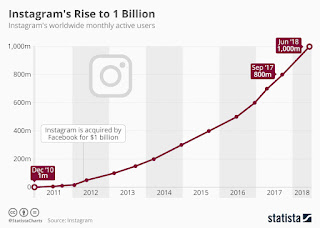
In 1962, Everett Rogers’s publication of Diffusion of Innovations introduced the question of how new innovation spreads and has the potential to obtain a permanent role in the lives of generations to come. In his book of theory, Roger details a few main elements that play a role in the process of diffusion: innovation, adopters, communication channels, time, and social system. To understand this process in a more modern way, I played around with the Com Tech Line dating events up to 2007, so it makes sense that many social media platforms did not make the cut.
Due to the overwhelming prevalence of Instagram, that includes business, art, personal branding and more, I chose to pose the question: How did Instagram get here? Before diving into the nitty, gritty details of how and when Instagram was born, I looked back at my very first memory of the platform. When I was about 11 years old, my friend had shown me her new Iphone with an app called Instagram. At that time, the feed was all photos taken from other areas of the internet with captions containing self-expressive quotes. Photos would get anywhere from 0-20 likes. But, sure enough the platform had the potential to give one billion people to share ideas, start or build a business, or even just connect with people from other corners of the planet.
In early 2010, two Stanford graduates by the names of Mike Krieger and Kevin Systrom coded a multi-faceted photo sharing platform called Burbn, that even featured filters to enhance photos. However, it failed and lead to further research on user behavior and voila! Instagram was later in the year. Below is a graph generated by Statista, that depicts the growth in Instagram's user volume, beginning with 25,000 on the first day it launched.
After growing without advertising the platform for two years, the two original founders sold their platform to Facebook for $1 billion in cash and stock. Since then, not only has the interface of the platform has changed over the years; user population, time spent using the app, ways to use the app for, and an overall influence on users' lives have all increased. The constantly added utilities and quality improvements were and continue to be to thank for the rapidly growing web of users. Nowadays, Instagram is even a commonplace for other apps, by making it easy to share videos and posts from other forms of social media. The easy ability to share and observe photos, information and other content in real time, for free, and grow your own popularity is also to thank... or blame?
In terms of consequences to such a prevalent alternate world, I had to consider that rising generations are increasingly influenced by this alternate universe that is social media. By only showing people what you want them to see, a form of escape is created and craves constant attention, meaning users are eager to post updates that support and align with the image they're trying to portray. I have gathered that most of the time, the image one wants to paint of themselves, is one based of altering the insecurities they face in the world of genuine interaction. When so much time is spent caring about things that are not even always real, and trying to portray a false image of perfection, a person's motivations can be skewed. This can also impact work ethic and ultimately have implications on mental health, vulnerability or even within the professional world.
Personally, checking my Instagram feed is the very first and the very last thing I do each day. I think I represent a fair amount of the Generation Z population when I admit that, according to my iPhone's "time spent" widget, I was spending roughly three of my waking hours each day, scrolling through Instagram. I have not checked since quarantine began... and I'm not going to.


No comments:
Post a Comment